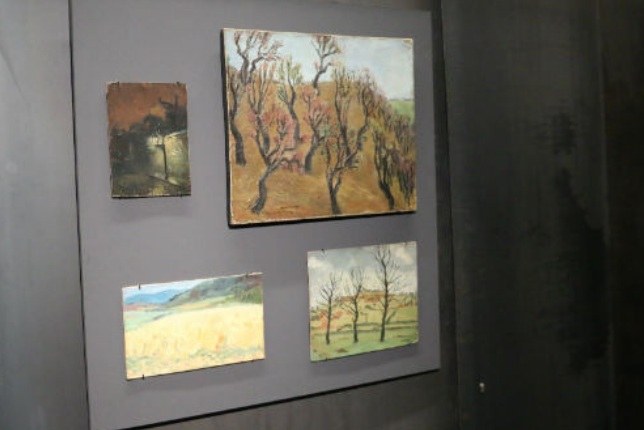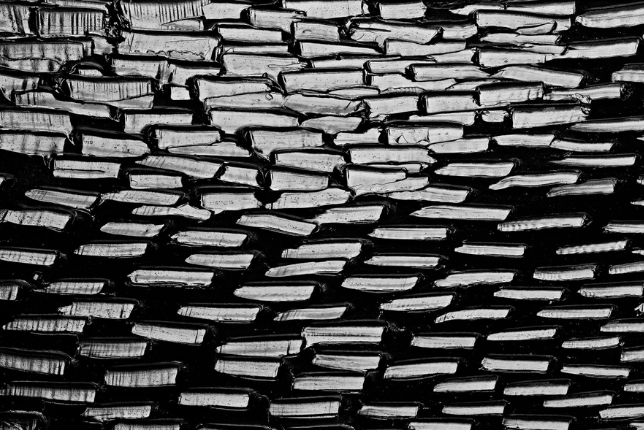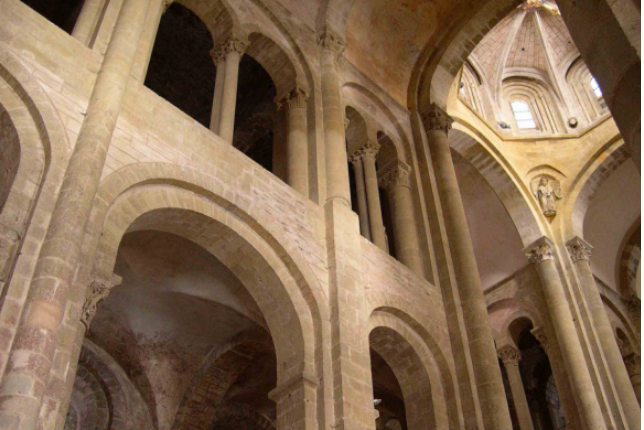
10 Things To Know about Pierre Soulages

Key dates in Pierre Soulage’s life
- 1919: He is born
- 1938: He moves to Paris to study art, but soon leaves
- 1941: He serves briefly in WWII
- 1941: He attends the École des Beaux-Arts in Montpellier for a short period
- 1943: He meets Sonia Delaunay who introduces him to abstract art
- 1946: He moves to Courbevoie, outside Paris, where he produces abstract works with heavy black brushstrokes
- 1947: He participates in his first exhibition
- 1954-66: His reputation expands and major museums begin purchasing his works
- 1987-1994: He designs over 100 stained glass windows for Sainte-Foy church
- 1979: He is elected a foreign honorary member of the American Academy of Arts and Letters
- 2019: Soulages’s 100th birthday
- 2022: Pierre Soulages died aged 102
Born in Rodez, Aveyron, Pierre Soulages is an important, impertinent artist in the French contemporary art scene. Although he remains firmly attached to his French roots, he is now internationally renown for his canvases, particularly his black monochrome paintings also known as “Outrenoir”. Artists from around the world cite him as an inspiration and pay tribute to his distinctive style. His enigmatic play with light and shadow never fails to be at once captivating and touching.
Today, Artsper has put together 10 facts that we think you should know about Pierre Soulages, so you can better appreciate his complex, dynamic universe.
1. He dropped out of the Beaux-Arts Academy in Paris

Pierre Soulages was passionate about art from a very young age, eventually moving to Paris aged 18 to apply for the Beaux-Arts academy. Once there, however, he quickly becqme frustrated by the strictly codified academic approach, which he found to be stifling. He returned to Rodez and later moved to Montpellier, where he regularly visited the Fabre Museum and later met the love of his life, Colette.
2. He lived in hiding during the Second World War

At the beginning of the Second World War, Pierre Soulage was mobilized for duty but then promptly demobilized again. After that, trying to avoid further trouble in Nazi-occupied Montpellier, he sourced false papers to escape being called up for compulsory service. Under this scheme, the Vichy government were sending French workers to Germany to help with the war effort. Instead, living under his false identity, Soulages spent this period working as a winemaker.
3. He initially refused the offer to make stained glass windows for the Abbey of Conques

In 1987, the President of the Delegation for Plastic Arts, Claude Mollard, invited Pierre Soulages to make stained glass windows to accompany a project based on French historical heritage. Soulages had recently taken on a similar project for the chapel in Aix, but was left frustrated by his efforts at working with glass. He refused the project, only changing his mind when Mollard suggested he work in Conques instead. This choice touched Soulages, because the town had played a key role in his discovery of art. Finally, he did take on the project, and the stunning results – 104 new windows – were inaugurated in 1994.
4. When he is not fully satisfied with one of his paintings, he burns it

Almost all artists battle creative blocks and lack of inspiration when they work, and Pierre Soulages is no exception. His methods for dealing with this, though, are pretty extreme. When he is not entirely happy with a work, he removes it from his easel and sets it aside. Then, once he has collected enough rejected pieces, he gathers them up and takes them to the woods to burn them. He has had his fair share of hard times and creative difficulties, during which almost all of his works in progress ended up on the bonfire.
5. An original glass was specially designed for the stained glass windows at Conques

Pierre Soulages wanted to make the best use of the glass possible, but also to respect and sublimate the colours and spaces of the cathedral. To do this, he decided to develop a particular glass, with the help of the glassmaker Jean-Dominique Fleury and the Saint Gobain Institute. This special material is made of agglomerated glass crystals, allowing for a better diffusion of light no matter the outside light levels.
6. He’s almost 100 years old

Pierre Soulages was born on 24th December, 1919, so this year will mark his 100th birthday. The Louvre is planning a major retrospective of his works, opening on December 11th and closing in March 2020. For his 90th birthday, he was celebrated by the Centre Georges Pompidou, who put on a similar exhibition to showcase works from across his extraordinary life. For the man himself, however, a birthday is just another day, and he spends it like he spends all of his other days: engrossed in his paintings. When asked about this, he explains that what matters most to him is “seeing my paintings live”.
7. He is one of the top-rated contemporary French artists at auction

On June 6th 2017, Pierre Soulages’s work “Painting 162 x 130 cm 14 April 1962” smashed the artist’s auction records with its eye-watering price tag of 6.1 million euros. Then, on 15th November 2018, his painting “Painting 186 × 143 cm, 23 December 1959” was sold for an astounding 9.6 million euros, or 11 million dollars. This marked a world first for the French artist and a resounding reaffirmation of his critical success. Pierre Soulages now is one of the most highly regarded contemporary French painters. His work is a staple for amateur collectors and gallery owners alike.
8. There is a museum named after him in Rodez (his hometown)

Inaugurated in 2014, the Soulages Museum in Rodez houses more than 250 works of art from Soulages in their permanent collection. They hold everything from examples of his earliest works – the monochromes – to his experimental engravings. This is not just a shrine to Soulages, though, as he initially refused the plans for the project. The build went ahead under the condition that there are more than 500 square meters set aside for a rolling display of exhibitions featuring other artists. According to Solages, this isn’t a purely selfless act: “An artist’s museum lasts for three years. The first year, everyone goes. The second year, too. After that, no one else.”
9. He is passionate about Prehistoric and Classical art

Pierre Soulages had his first artistic experience in Conques, where he was fascinated by the Classical architecture in the cathedral. Later, he read about cave paintings and prehistoric art, and was immediately enraptured. It was with this raw and naive approach that he went to Paris for the first time, and this perhaps explains which he struggled so much with the institutionalized fine art he found there. Once he dropped out of the academy, he spent the rest of his life pursuing his joint passions.
10. His paintings have no titles

Pierre Soulages seeks to remove all lyricism from his painting. His works are directly presented, without embellishment. He sees his paintings and engravings as experiences in and of themselves, and as means to interact with the viewer. His works are defined by their stark materiality and domineering presence, not by the words assigned to them.
Key Soulages exhibitions
- 1947: His first exhibition, at the Salon des Surindépendants, Paris
- 1949: His first solo exhibition, at the Galerie Lydia Conti, Paris
- 1954: Soulages at Kootz Gallery, New York
- 1960: Retrospective at Kestner Gesellschaft, Hanover
- 1980: Retrospective at Gimpel Gallery, New York
- 1994: His stained-glass windows are installed at Sainte-Foy church for permanent display
- 2014: The Musée Soulages opens in Rodez, France
- 2019: The Louvre hosts a solo exhibition of Soulage’s work to mark his 100th birthday

About Artsper
Founded in 2013, Artsper is an online marketplace for contemporary art. Partnering with 1,800 professional art galleries around the world, it makes discovering and acquiring art accessible to all.
Learn more












